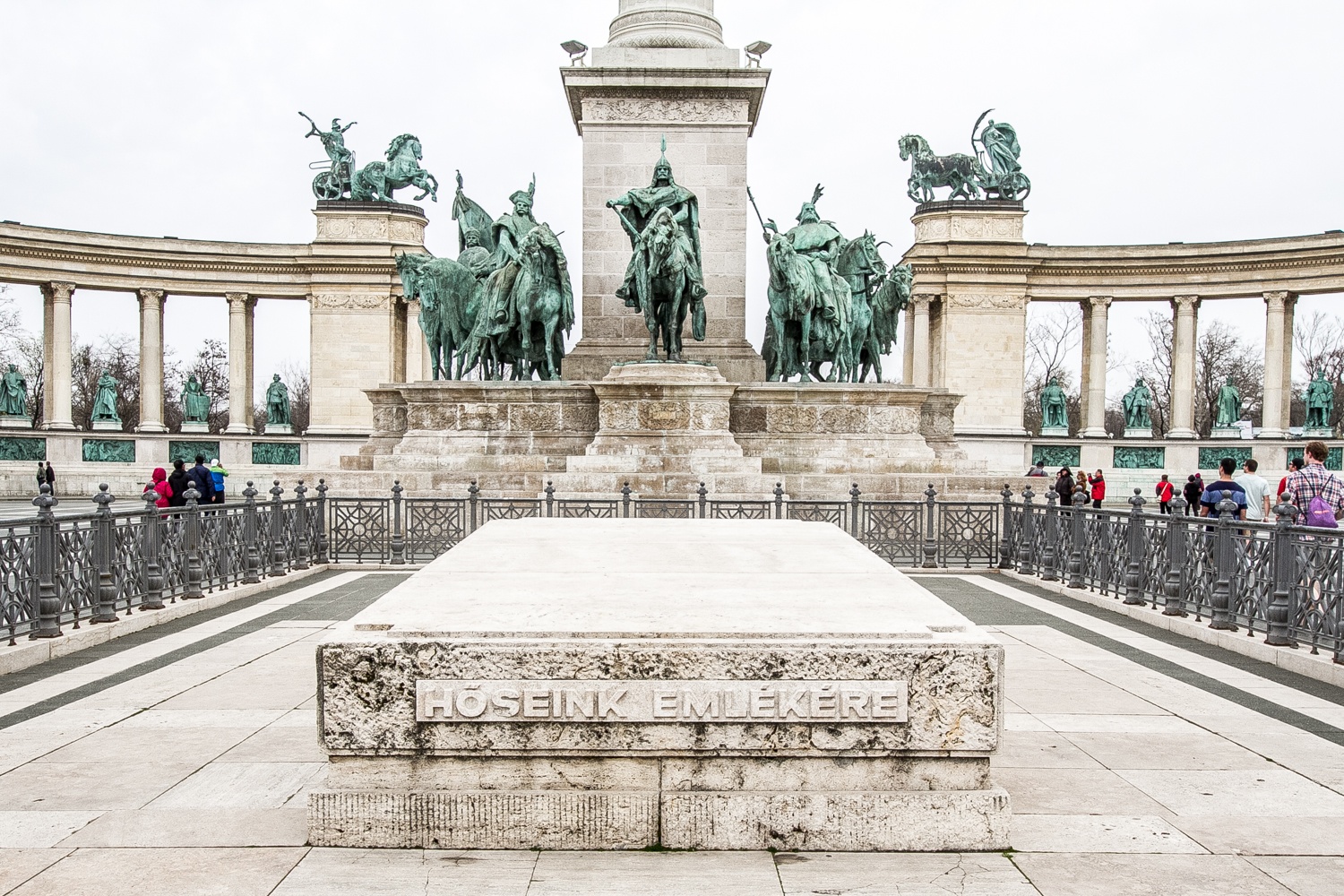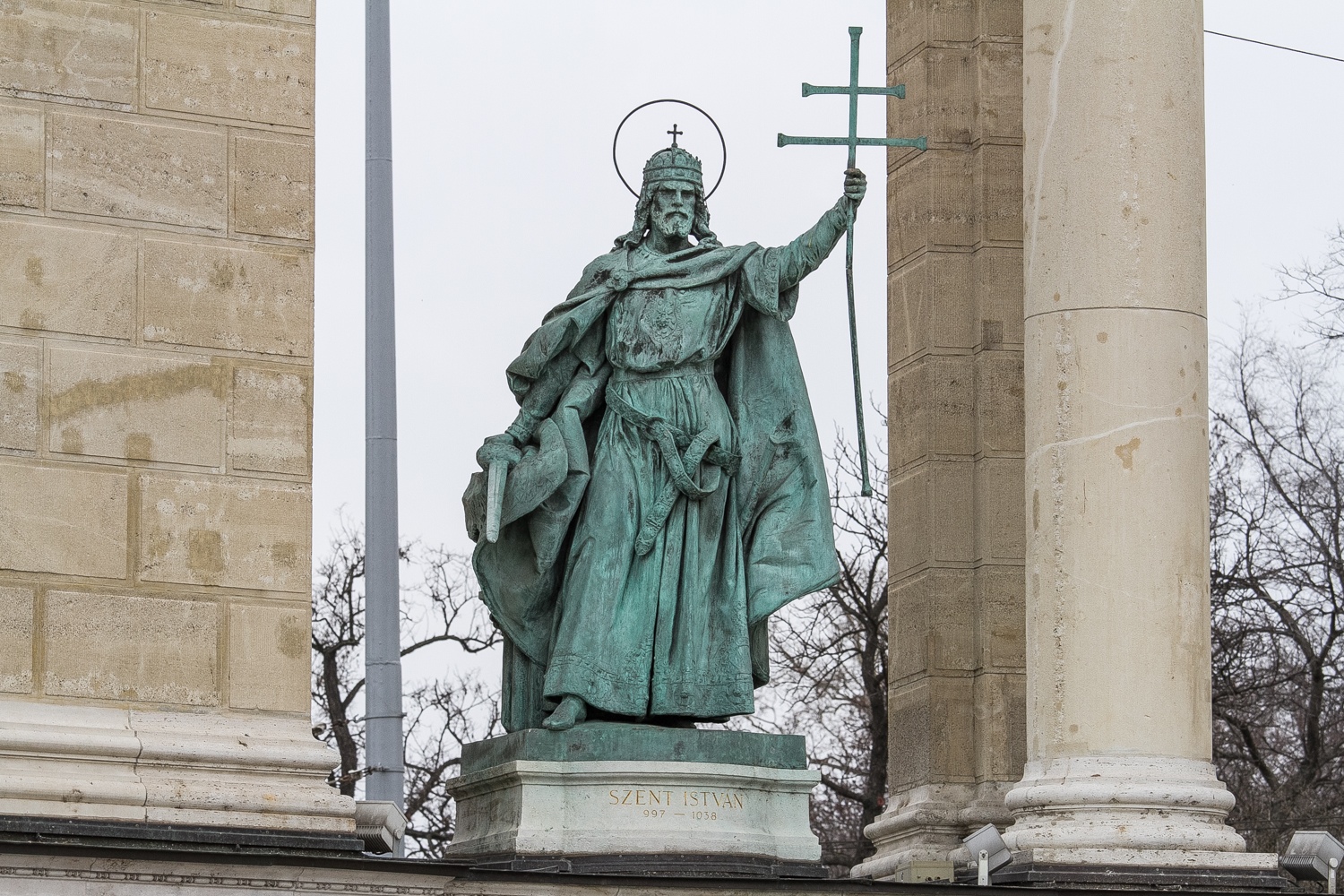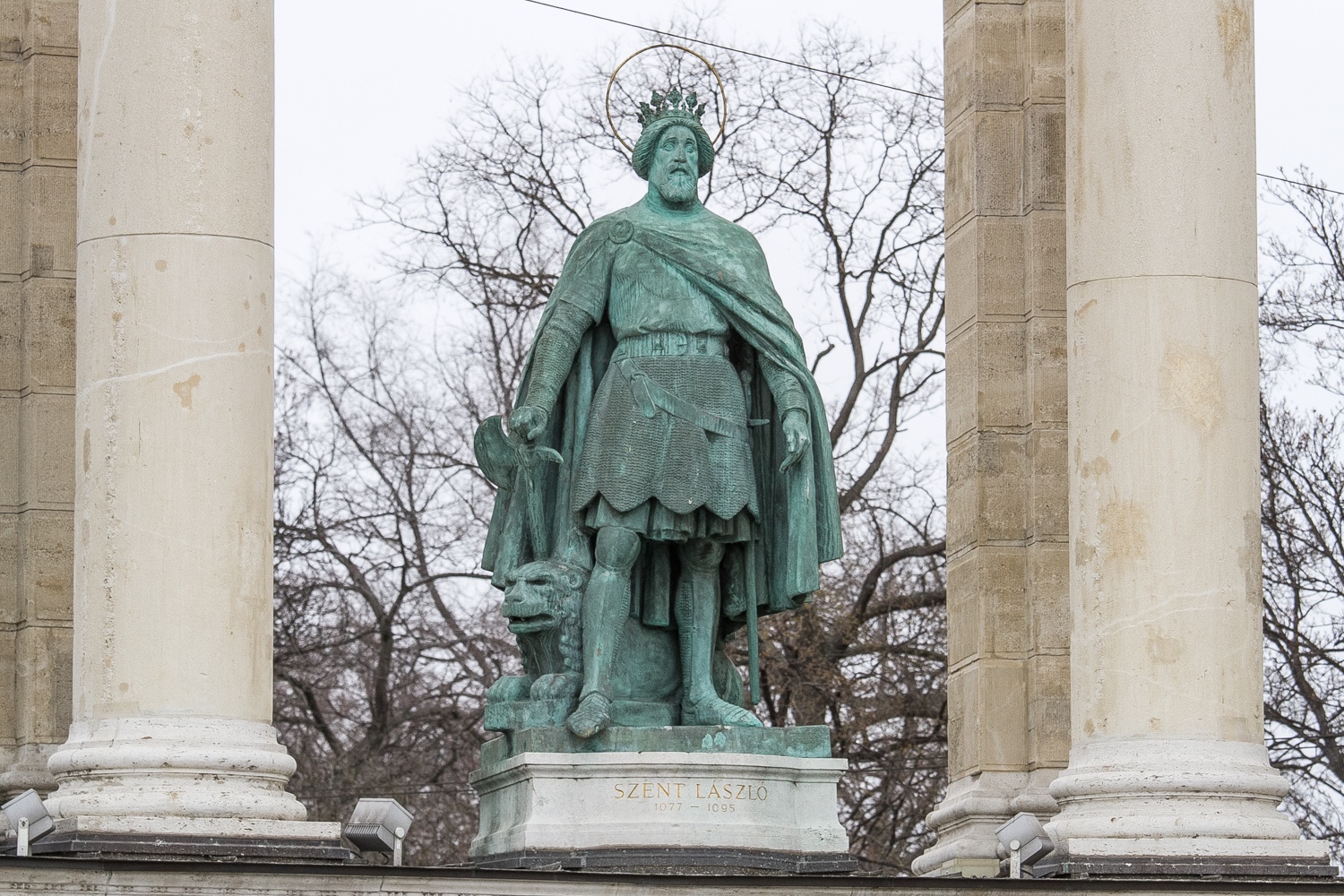Table of Contents
- 1 / 16 - -
- 2 / 16 - The Seven Chieftains
- 3 / 16 - Szent István/Stephen I
- 4 / 16 - Szent László/Saint Ladislaus
- 5 / 16 - Könyves Kálmán/Coloman the Learned
- 6 / 16 - II András/Andrew II
- 7 / 16 - IV Béla/Béla IV
- 8 / 16 - Károly Róbert/Charles I
- 9 / 16 - Nagy Lajos/Louis I
- 10 / 16 - Hunyadi János/John Hunyadi
- 11 / 16 - Mátyás/Matthias Corvinus
- 12 / 16 - Bocskai István/Stephen Bocskai
- 13 / 16 - Bethlen Gábor/Gabriel Bethlen
- 14 / 16 - Thököly Imre/Count Imre Thököly de Késmárk
- 15 / 16 - II Rákóczi Ferenc/Francis II Rákóczi
- 16 / 16 - Kossuth Lajos/Louis Kossuth
1/16
-
Erected in 1896 as the centerpiece of Hungary’s Millennial Celebrations to commemorate the 1,000-year anniversary of Central Asia’s nomadic Magyar tribes first settling down in the Carpathian Basin, the grand monument of Heroes’ Square offers a physical synopsis of Hungarian history, beginning with the central horseback embodiment of the seven original tribal leaders and then progressing through time with each individual statue in the colonnade. We take a look at all of these hallowed sculptures and share some insight on the consequential deeds of every hero depicted, while providing translations for the Hungarian text inscribed below them to present some background about the relief statues that portray epoch-making incidents of the Magyar saga.
2/16
The Seven Chieftains
Wearing intimidating medieval armor adorned with feathers and antlers, the seven horseback warriors that surround the central column of Heroes’ Square are the tribal leaders who brought the Magyar people to the land that is now Hungary around A.D. 896. Details of this period are sketchy because of contradictory historical records of the Dark Ages, but it’s widely accepted that this was when Árpád and six other clan lords (Előd, Huba, Kond, Ond, Tas, and Tétény) crossed the Carpathian Mountains with their subjects to conquer this territory, soon gaining dominance over several disparate populations that occupied the region at the time; the Árpád Dynasty went on to rule Hungary for some 400 years.
3/16
Szent István/Stephen I
Still exalted today as the nation’s founder, Saint Stephen was the first King of Hungary and the first devout Christian to lead this country; he could only rise to power after defeating his pagan uncle Koppány in a fateful battle for the nation’s spiritual future. Depicted on the relief below his statue, Stephen was enthroned on Christmas Day of the year 1000 with the support of Pope Sylvester II, internationally establishing this land as the Magyar domain – but it took years for him to unite the Hungarian people as a Christian citizenry, brutally punishing those who refused to accept their king’s faith. Nonetheless, Stephen reigned over a relatively peaceful and prosperous period of 40 years.
Inscription: ISTVÁN AZ 1000 ÉV KARÁCSONYÁN KORONÁT KAP A PÁPÁTÓL. – “On Christmas of the year 1000, Stephen receives a crown from the Pope.”
4/16
Szent László/Saint Ladislaus
As a young Magyar nobleman, chivalrous Ladislaus fought Turkic invaders in Transylvania; according to legend, amid one battle he spotted an enemy warrior abducting a Hungarian girl, and valiantly chased him to rescue the maiden in a violent horseback tussle before beheading the barbarian – and this is the scene portrayed below the Ladislaus statue at Heroes’ Square. Ladislaus was crowned King of Hungary in 1077 and soon afterwards canonized his forefather Stephen, but he had to see his realm through multiple civil wars before leading the country into a period of widespread expansion. Several miracles are attributed to Ladislaus, and he was canonized about a century after his death in 1095.
Inscription: LÁSZLÓ LEGYŐZI A LEÁNYRABLÓ KUN VITÉZT. – “Ladislaus defeats the maiden-abducting Cuman soldier.”
5/16
Könyves Kálmán/Coloman the Learned
Colomon was born physically disabled, so his uncle Ladislaus arranged for him to join the priesthood; while in seminary he became highly educated for that time. However, after a power struggle with his brother Álmos that would continue for two decades, Colomon ascended the throne in 1096 to oversee a tumultuous kingship – he dealt mercilessly with marauding fighters passing through Hungary during the First Crusade, and later the Hungarian army invaded Croatia to vanquish its last native king. Yet Colomon is best known for his proclamation that vampires and witches do not exist, sparing many religiously persecuted people from being burnt at the stake, as portrayed on Colomon’s relief sculpture.
Inscription: KÁLMÁN KIRÁLY ELTILTJA A BOSZORKÁNY ÉGETÉST. – “King Coloman prohibits the burning of witches.”
6/16
II András/Andrew II
The fruitlessly violent reign of Andrew II is characterized by wars fought near and far – after being crowned King of Hungary in 1205, he waged more than a dozen failed campaigns to expand his territory into the Slavic northeast, and in 1217 he led a crusade into the heart of the Holy Land that yielded little beyond some plundered relics; nonetheless, the relief below Andrew’s statue represents his pious offensive. Returning to Hungary in massive debt from these military misadventures, Andrew raised taxes to the extent that his vassals rose up to demand a royal charter to guarantee the privileges of his noble subjects – the Golden Bull of 1222, leading to the rise of Hungary’s aristocracy.
Inscription: II ANDRÁS KERESZTESHADJÁRATOT VEZET JERUZSÁLEM FELSZABADÍTÁSÁRA. – “Andrew II leads a crusade to liberate Jerusalem.”
7/16
IV Béla/Béla IV
Inheriting a weakened nation from his father Andrew II, Béla IV was enthroned in 1235 and attempted to restore his royal influence, but a few years after his coronation the Mongols invaded Hungary to wreak widespread devastation before inexplicably withdrawing; Béla’s relief portrays a grim scene of Magyar soldiers’ corpses piled high in the attackers’ wake. Left with his domain in tatters, Béla went about reconstructing Hungary and preparing for any subsequent invasion by encouraging his lieges to build fortifications and raise private armies, while forging strategic alliances with neighboring countries and welcoming colonists from surrounding regions to settle in his depopulated provinces.
Inscription: IV BÉLA A TATÁRJÁRÁS UTÁN FELÉPÍTI AZ ORSZÁGOT. – “Béla IV rebuilds the country after the Mongol invasion.”
8/16
Károly Róbert/Charles I
The politically complicated sovereignty of Charles I began in 1301 with his receiving a provisional crown amid conflicting claims to royal authority; most Magyar nobles did not acknowledge his ascension, and Charles was forced to withdraw to the southern territory of his kingdom. Although Pope Boniface VIII declared Charles the lawful king in 1303, by this time Hungary had dissolved into 12 provinces with their own oligarchs, and so Charles began a long campaign of reclaiming lands within his own realm by fighting for one dominion after another, often assisted by minor lords of each region. By 1321 Charles could finally declare dominance over the entire country, establishing a reunited Hungary.
Inscription: There is no inscription above the relief of Charles I, because it was removed for political reasons during Hungary's era under Soviet control... but we can glean much from the scene of a brutal horseback battle happening as the king and a lord shake hands in the distance.
9/16
Nagy Lajos/Louis I
Known as Louis the Great, the son of Charles I inherited a centralized kingdom and a healthy economy when he was crowned in 1342, and went on to become one of Hungary’s most powerful monarchs of all time. Almost immediately after assuming power, Louis restored authority over Croatia and defeated a Tatar army before marching into the Kingdom of Naples (depicted on his relief sculpture), greatly expanding Hungary’s influence to the east and west; after repelling the Golden Horde, he invaded Serbia and inherited the Kingdom of Poland, further increasing his clout to the south and north as well. At the height of his power, Louis established an empire encompassing most of Eastern Europe and beyond.
Inscription: NAGY LAJOS BEVONUL NÁPOLYBA 1348. – “Louis I marches into Naples in 1348.”
10/16
Hunyadi János/John Hunyadi
As the scion of Transylvanian nobility, Hunyadi was on the front lines when the Ottoman Empire began expanding toward Europe in the 1430s, earning acclaim by valiantly leading successful raids against the Turks as a young knight. With his innovative military mind, Hunyadi earned promotions that culminated in his being proclaimed Regent of Hungary, charged with defending the southern borders – and in 1456, when the Ottoman troops began an invasion of Hungary with a siege of Belgrade, Hunyadi led an army to successfully defend the southern city, represented in his relief. Although Hunyadi died three weeks after this triumph, his victory kept the Turks away from Hungary for another six decades.
Inscription: HUNYADI NÁNDORFEHÉRVÁRI GYŐZELMÉVEL MEGÁLLÍTJA A TÖRÖK HÓDÍTÓKAT. – “Hunyadi stops the Turkish invaders after his triumph at Belgrade.”
11/16
Mátyás/Matthias Corvinus
The Renaissance arrived in Hungary during the mid-1400s thanks to Matthias, the son of John Hunyadi and a notable patron of art and science. After a messy succession struggle that saw his older brother executed, Matthias was proclaimed king in 1458. While his three-decade reign experienced significant warfare, he is best remembered for his cultural contributions to Hungary – he promoted artistic development, launched major building projects, created a royal library, and enjoyed conversations with prominent Humanist scholars, as depicted in his relief statue. Legend has it that Matthias often disguised himself to walk through his kingdom and learn what the commoners thought of current affairs.
Inscription: MÁTYÁS KIRÁLY TUDÓSAI KÖRÉBEN. – “King Matthias among his scholars.”
12/16
Bocskai István/Stephen Bocskai
Hungary fell to the Ottomans in 1526, and then became a battlefield between the Turks and Austria’s Habsburg Empire for the next two centuries. Born into a noble Transylvanian family in 1557, Bocskai began his political career as a Habsburg supporter, successfully leading an army against Ottoman troops in 1595… but when Habsburg rulers subsequently imposed tyrannical control over Transylvania, Bocskai protested against Austrian rule with widespread popular support, victoriously leading homegrown armies against Habsburg troops (seen in his relief). After his election as Prince of Transylvania in 1605, Bocskai was instrumental in negotiating peace treaties with both the Austrians and the Turks.
Inscription: BOCSKAI HAJDÚI HARCBAN A CSÁSZÁRI ZSOLDOSOKKAL. – “Bocskai’s Hajdú soldiers at war with the imperial mercenaries.”
13/16
Bethlen Gábor/Gabriel Bethlen
As another member of Transylvania’s aristocracy, Bethlen supported Bocskai and his successor Gábor Báthory, but when Bethlen fell out with the new leader he took refuge with the Ottomans. The Turks provided Bethlen with an army to return home and drive Báthory out of power, and Bethlen was proclaimed Prince of Transylvania in 1613, going on to conquer most of Habsburg-held northern Hungary and seize the Crown of St. Stephen. After forging an alliance with the Czechs – as depicted in his relief – Bethlen agreed to return the crown in exchange for a Habsburg treaty securing Hungarian civil rights. Bethlen then made efforts to expel the Turks from Hungary, but died before this could be achieved.
Inscription: BETHLEN SZÖVETSÉGET KÖT A CSEHEKKEL 1620. – “Bethlen allies with the Czechs in 1620.”
14/16
Thököly Imre/Count Imre Thököly de Késmárk
As the Habsburg-Ottoman conflict continued through the 17th century, Thököly was the son of a northern-Hungary noble who opposed the Austrians and was killed by their troops, causing the young count to flee to Transylvania. There he met fellow anti-Habsburg refugees who allied to revolt against Austrian rule under Thököly’s leadership in 1678; with Ottoman support the rebels won many battles (pictured in the relief), and the Turks declared Thököly as Prince of Upper Hungary in 1682. However, after the Ottomans lost the Battle of Vienna in 1683, Thököly’s good fortune waned as he suffered multiple losses to the Austrians, eventually living out the rest of his days in exile near Constantinople.
Inscription: THÖKÖLY KURUCAI A SZIKSZÓI HARCBAN LEGYŐZIK A LABANCOKAT 1679. – “Thököly’s kuruc army defeats the labancz troops in the Szikszó battle in 1679.”
15/16
II Rákóczi Ferenc/Francis II Rákóczi
The stepson of Thököly, Rákóczi was born into one of Hungary’s richest families in 1676; after Thököly’s loss against the Habsburgs, Rákóczi was asked to carry on the freedom fight as its leader. After initial reluctance to assume this role, Rákóczi forged an alliance with King Louis XIV of France to launch a new revolution in 1703 with a peasant army headed by Tamás Esze – portrayed in the relief – and the rebellion enjoyed early success; Rákóczi was declared Prince of Transylvania in 1704. However, the French loss at the Battle of Blenheim prevented Rákóczi’s allies from assisting his underfunded troops, and many military defeats followed; Rákóczi fled for Poland in 1711, taking refuge in Turkey until his death.
Inscription: ESZE TAMÁS JOBBÁGYSEREGÉVEL FOGADJA A HAZATÉRŐ RÁKÓCZIT. – “Tamás Esze welcomes Rákóczi, returning home with his serf army.”
16/16
Kossuth Lajos/Louis Kossuth
Austria’s oppression of Hungary continued into the 19th century, but revolution spread across Europe in 1848; in March of that year, Kossuth – a brilliant reformist politician – demanded a parliamentary government for Hungary, earning widespread support among the Magyar populace. After the Hungarian Revolution of 1848 broke out on March 15th, Kossuth became its leader; while his speeches inspired many to fight (as depicted in his relief), Kossuth struggled with maintaining unity among his generals, leading to disorganized campaigns against reprisals by Habsburg troops. Despite several impressive victories, the Magyar army was defeated in the summer of 1849, and Kossuth died decades later in exile.
Inscription: KOSSUTH FEGYVERBE HÍVJA AZ ALFÖLD NÉPÉT. – “Kossuth calls the people of the Great Plains to arms.”



















